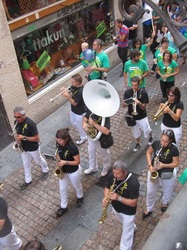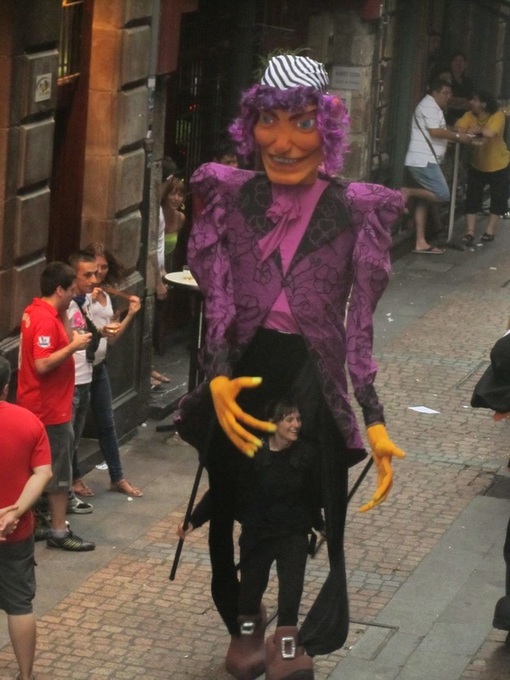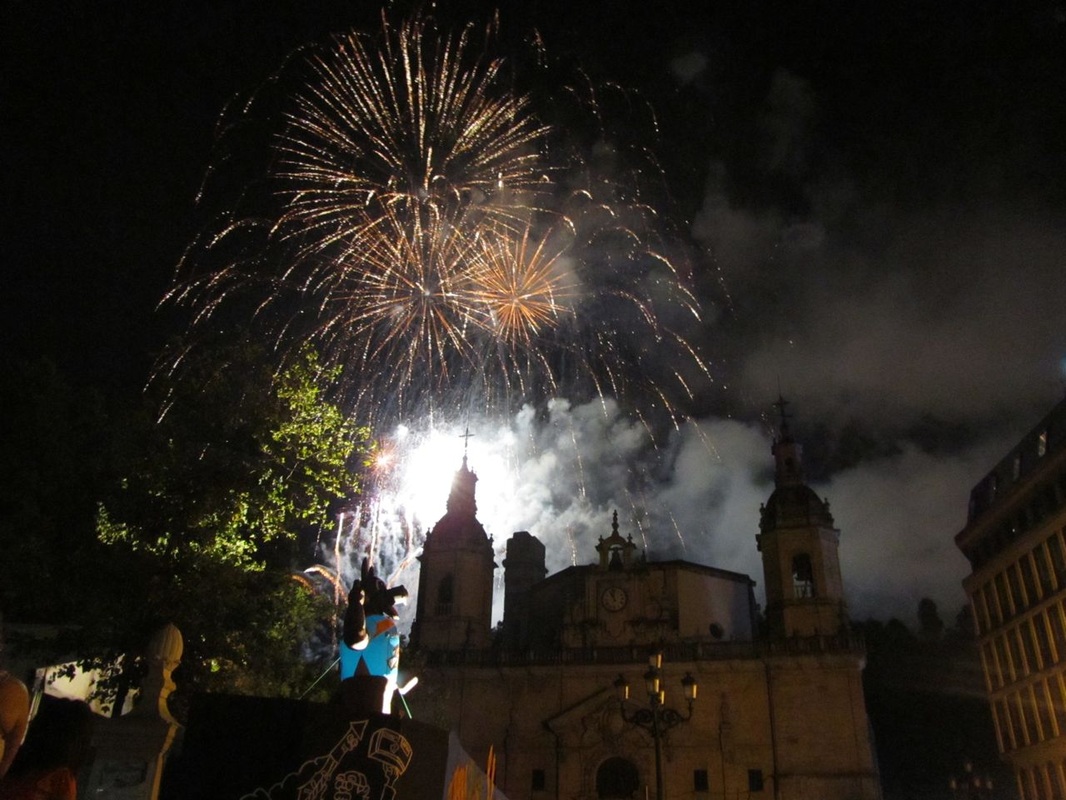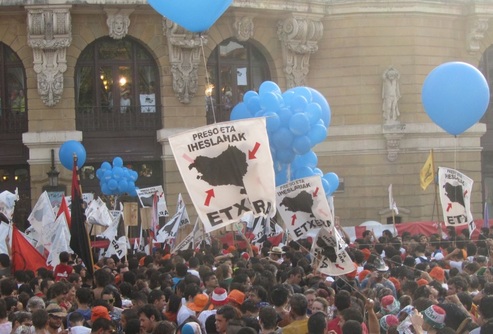(*‘Ongi etorri’ is the Basque phrase for ‘welcome’.)
Well, Aste Nagusia – the week of the fiestas – has been and gone, and very marvellous it was too.
It all kicked off two Saturdays ago at 5pm. Just as we were preparing to go and watch the launch of the fiesta in the Arenal (the big public square by the river, five minutes walk from our flat), the fiesta came to us. About two dozen brass bands, wind bands and pipe and drum bands marched down our street, each one accompanied by groups of revellers, all on their way to the Arenal. Thousands of people passed by in the space of about 45 minutes. There was a wonderful joyful carnival atmosphere, and the musical standards were great – superb brass and wind playing in all the bands. It was a baking hot day and each time the parade stopped because of a log-jam further down the street the crowds looked up to the people watching from their balconies and shouted ‘Agua! Agua!’, begging us to throw buckets of water over them – which we duly did!
Well, Aste Nagusia – the week of the fiestas – has been and gone, and very marvellous it was too.
It all kicked off two Saturdays ago at 5pm. Just as we were preparing to go and watch the launch of the fiesta in the Arenal (the big public square by the river, five minutes walk from our flat), the fiesta came to us. About two dozen brass bands, wind bands and pipe and drum bands marched down our street, each one accompanied by groups of revellers, all on their way to the Arenal. Thousands of people passed by in the space of about 45 minutes. There was a wonderful joyful carnival atmosphere, and the musical standards were great – superb brass and wind playing in all the bands. It was a baking hot day and each time the parade stopped because of a log-jam further down the street the crowds looked up to the people watching from their balconies and shouted ‘Agua! Agua!’, begging us to throw buckets of water over them – which we duly did!
Each band and accompanying group of revellers – 27 of them in all – wore a different set of matching clothing. We later learnt that these 27 groups are the ‘konpartsak’ - local associations representing different areas of the city or different interest groups (e.g., political, sporting or musical) that exist to come together to organise the week of fiestas in conjunction with the city council. They also organise festivities at other times of year – major saint’s days, Christmas, and carnival in February, etc.
Each ‘konpartsa’ sets up a festive tent (a ‘txosna’) in the Arenal which acts both as a public bar and as a base for that konpartsa for the week. The square is transformed into a huge street party, and each evening thousands of people go to drink and talk at these various ‘txosnas’ in the square. (We are beginning to realise how important meeting and drinking outdoors is for the Spanish, an observation which has now been corroborated by many we’ve spoken to. We’ve been told too that there isn’t much of a culture of inviting people into your house: you simply agree to meet outside.)
Each ‘konpartsa’ sets up a festive tent (a ‘txosna’) in the Arenal which acts both as a public bar and as a base for that konpartsa for the week. The square is transformed into a huge street party, and each evening thousands of people go to drink and talk at these various ‘txosnas’ in the square. (We are beginning to realise how important meeting and drinking outdoors is for the Spanish, an observation which has now been corroborated by many we’ve spoken to. We’ve been told too that there isn’t much of a culture of inviting people into your house: you simply agree to meet outside.)
After this parade, we headed to the Arenal for the launch of the fiestas. The square was crammed with several thousand people, all waiting for the appearance of ‘Marijaia’ – the symbol of the Bilbao fiestas (each city has its own symbol) – on the balcony of the opera house (the main building on the square.) Marijaia is a sort of tame, urban version of ‘Mari’, the Basque pre-Christian mountain goddess who is supposed to live on Mount Amboto, about 30 miles away. She’s an effigy of a Basque woman with arms up-stretched in a gesture of joy. She appears on the balcony and the fiesta is then launched with a massive explosion of ticker tape, deafening cheers, and mass singing of a Basque song (no idea what it was…!) Meanwhile, during the wait for Marijaia’s appearance, crowds of hundreds of young people were amusing themselves by throwing flour, eggs, beer and tomato ketchup over each other….
One of the most interesting things about all this – the parade, the launch, the flour and eggs and so on – was the fact that it was all done without any drunkenness or aggression, without any undercurrent of violence – just a joyous lack of restraint. Indeed, one of the remarkable things about the whole week was the complete lack of excess or drunkenness. Even at the various late-night concerts around town, hundreds of young people would come to watch bringing a bag of soft drinks to keep themselves hydrated and to counteract the effects of any alcohol. We couldn’t help feeling that it would all be a bit different in Britain.
Next day, the parade of ‘Los Gigantes’ across the city – a group of huge puppets representing figures from Bilbao’s past, including a British footballer (with pasty skin and a handkerchief on his head – see previous post for explanation). They were accompanied by traditional Basque pipe and drum bands (of which more later), and by a mini-parade of what we later learnt were called ‘cabezones’ (big-heads’, young people wearing ‘big heads’ and carrying inflated pigs’ bladders (!) with which they hit children in the crowd – not hard, I hasten to add: apparently, a custom at fiestas in other parts of Spain, too. All very carnivalesque, all very reminiscent of ancient ideas about festivals and ‘misrule’.
Next day, the parade of ‘Los Gigantes’ across the city – a group of huge puppets representing figures from Bilbao’s past, including a British footballer (with pasty skin and a handkerchief on his head – see previous post for explanation). They were accompanied by traditional Basque pipe and drum bands (of which more later), and by a mini-parade of what we later learnt were called ‘cabezones’ (big-heads’, young people wearing ‘big heads’ and carrying inflated pigs’ bladders (!) with which they hit children in the crowd – not hard, I hasten to add: apparently, a custom at fiestas in other parts of Spain, too. All very carnivalesque, all very reminiscent of ancient ideas about festivals and ‘misrule’.
During the week, we never knew what would appear outside our flat next: as well as the bands that regularly paraded past (often stopping to play right outside our flat at one of the popular bars), ‘Los Gigantes’ paraded past a couple of times, various other enormous puppets, too – and even Marijaia herself came past. Rather delightfully, the puppets were so big that their heads were at the level of our first floor balcony and we found ourselves face to face with them!
There were also daily performances, around the Casco Viejo, of Basque country dancing and something called ‘bertsolari’ – an extraordinary oral tradition of improvised verse-chanting: I will write more about these in a future post. Each night, too, there was a huge fireworks display over the city at about 11 pm – which signalled the start of a night of festivities, with people dancing and drinking in the square till the early hours, and open-air concerts beginning at 11.30pm...
Beyond the various special events of the fiesta, there was a permanent atmosphere around the town of community festivity, with local people – whether dancers, verse-reciters, musicians, revellers, or simply onlookers – at the centre of it all. Difficult to think of something equivalent at home. It all felt very happy and positive and in many senses inclusive (though I hope to write at some point later about the potential exclusivity of Basque national folklore in a modern multi-cultural city…)
Sadly, we missed the last weekend of the fiestas. At the end of the whole thing, Marijaia is apparently burnt, her ashes sent off down the river, only to rise again phoenix-like the following year.
Finally, quiet political protest was quite strongly in evidence. Here are some pictures:
Sadly, we missed the last weekend of the fiestas. At the end of the whole thing, Marijaia is apparently burnt, her ashes sent off down the river, only to rise again phoenix-like the following year.
Finally, quiet political protest was quite strongly in evidence. Here are some pictures:






























 RSS Feed
RSS Feed